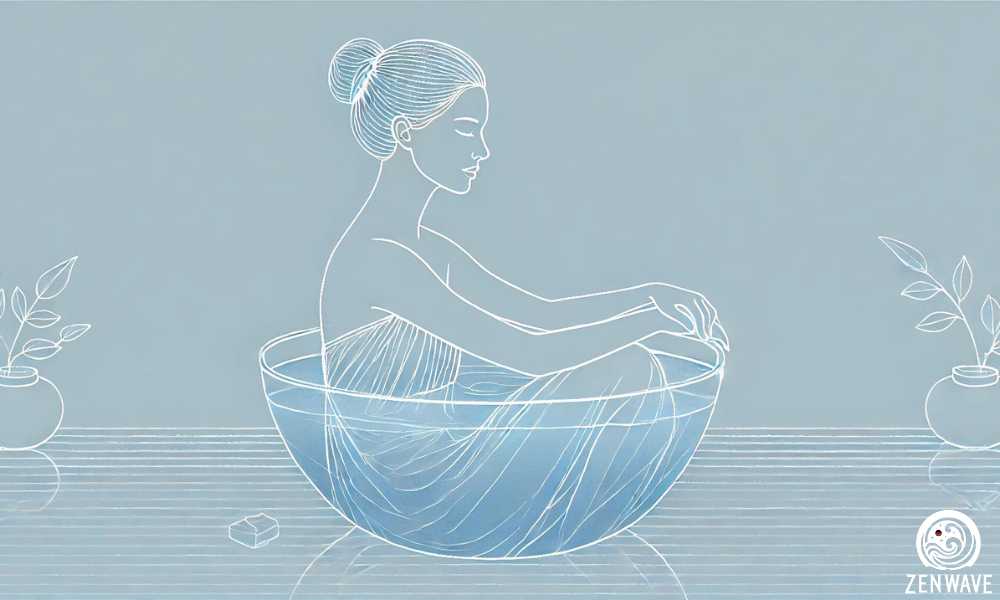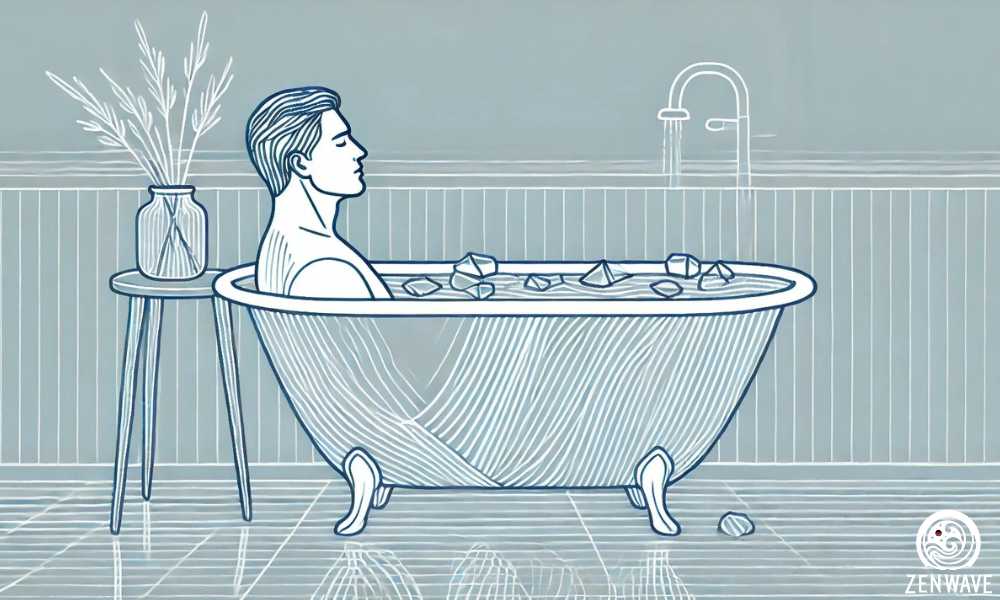In a world obsessed with comfort, there’s a growing trend that’s turning heads and raising eyebrows – the art of ice bathing. Once the domain of elite athletes and daring adventurers, this invigorating practice is now making waves in mainstream wellness circles. But what’s behind this frosty phenomenon?
From boosting metabolism to enhancing mental resilience, ice baths offer a treasure trove of benefits that might just make you rethink your relationship with cold.
Join us as we plunge into the science-backed world of ice baths and discover why sometimes, the coldest path might be the hottest trend in health and wellness.
Physical Benefits: The Body’s Cold Response
Muscle Recovery and Reduced Inflammation
When you immerse yourself in cold water, blood vessels constrict, reducing blood flow to the muscles. This process, known as vasoconstriction, helps to flush out metabolic waste products like lactic acid that accumulate during intense exercise. As you exit the ice bath and your body warms up, blood vessels dilate, allowing fresh, oxygen-rich blood to flow back into the muscles. This cycle of constriction and dilation can significantly reduce inflammation and muscle soreness.
A 2021 study demonstrated that cold water immersion therapy led to notable improvements in agility, speed, power, and balance in college athletes. The cold exposure helped decrease muscle fatigue and inflammation, enabling quicker reinstatement of optimal physical performance.
Enhanced Circulation
Ice baths provide a form of “vascular exercise” for your circulatory system. The rapid constriction of blood vessels in response to cold, followed by dilation as you warm up, can improve overall circulation. This process can strengthen blood vessels over time, potentially leading to better cardiovascular health.
Improved circulation can have wide-ranging benefits, including better nutrient delivery to tissues, more efficient waste removal, and potentially reduced risk of cardiovascular diseases. Some studies suggest that regular cold exposure can even lead to the formation of new blood vessels, a process known as angiogenesis.
Metabolism Boost and Fat Burning
Cold exposure activates brown adipose tissue (BAT), a type of fat that burns calories to generate heat. Unlike white fat, which stores energy, BAT uses energy to maintain body temperature in cold conditions. Regular activation of BAT through cold exposure may increase your overall metabolic rate.
A 2014 study found that exposing mice to cold temperatures three times per week doubled their metabolic rates during the exposure due to brown fat activation. In humans, research has shown that cold water immersion can increase metabolic rate by up to 350% in water temperatures around 57°F (14°C).
Improved Skin and Hair Health
The cold water from ice baths can benefit your skin and hair in several ways. When exposed to cold, pores tighten, which can help reduce the production of excess oil (sebum) and potentially decrease acne breakouts. The cold can also calm inflammatory skin conditions like eczema or sunburn by reducing redness and swelling.
For hair, cold water can help seal the hair cuticle, leading to smoother, shinier hair. It may also strengthen hair follicles and reduce hair loss. The improved circulation from cold exposure can nourish both skin and scalp, potentially leading to a healthier complexion and stronger hair growth.
Immune System Support
Brief, controlled exposure to cold water can stimulate the immune system. Research has shown that regular cold water immersion can increase the production of white blood cells, which are crucial for fighting off infections and diseases.
A 2022 analysis of regular winter swimmers found lower oxidative stress and more antioxidants compared to non-swimmers, indicating reduced inflammation and potentially improved immune function from repeated cold immersion.
Hormonal Benefits
For men, ice baths may help boost testosterone levels. The cooler temperatures can optimize testicular function, as the testes operate best at temperatures slightly below body temperature. A 2013 study found that men had higher sperm quality in colder winter months, suggesting a link between cooler temperatures and reproductive health.
For women, while research is still preliminary, some studies suggest that cold therapy might help improve menstrual regularity and fertility. A study on rats with polycystic ovarian syndrome (PCOS) found that cold water therapy led to more regular cycles, lower androgen levels, increased ovulation, and improved fertility rates.
Insulin Sensitivity
Cold exposure may help improve insulin sensitivity, which is crucial for regulating blood sugar levels. When insulin sensitivity improves, cells can more effectively use glucose from the bloodstream, potentially reducing the risk of type 2 diabetes.
One trial had diabetics take 10 days of 60°F baths. The cold water activated their brown fat, improving insulin sensitivity by 43%. This suggests that regular ice baths could be a valuable tool in managing blood sugar levels and reducing diabetes risk.
Mental and Emotional Benefits: Chilling Out for Better Mental Health

Stress and Anxiety Reduction
Ice baths can activate the parasympathetic nervous system, often referred to as the “rest and digest” system. This activation can help counteract the effects of chronic stress and reduce anxiety levels. The cold exposure also triggers the release of norepinephrine, a neurotransmitter that can help improve mood and reduce stress.
A well-referenced study found that immersion in 57°F water increased levels of noradrenaline by 530% and dopamine by 250%, chemicals that boost mood, motivation, and alertness.
Enhanced Mood and Mental Resilience
The release of endorphins during an ice bath can create a natural high, leading to improved mood and a sense of well-being. This “cold euphoria” can last for hours after the bath. Regular practice of cold immersion can also build mental toughness and resilience, as individuals learn to push through discomfort and challenge their perceived limitations.
Improved Sleep Quality
Taking an ice bath a few hours before bedtime could improve sleep quality. The body naturally lowers its core temperature to initiate sleep, and an ice bath can kickstart this process. Additionally, the stress-reducing effects of cold immersion can help calm the mind, making it easier to fall asleep and potentially improving the quality of sleep.
Increased Focus and Alertness
The shock of cold water can increase alertness and mental clarity. This is partly due to the release of norepinephrine, which can enhance focus and attention. Many people report feeling more awake and mentally sharp after an ice bath, which could be beneficial for cognitive tasks and overall productivity.
Boosted Willpower and Motivation
Regularly facing the challenge of an ice bath can strengthen willpower and boost motivation. Each time you overcome the initial discomfort of the cold, you’re training your mind to push through challenges. This mental fortitude can translate to other areas of life, potentially improving discipline and determination in pursuing goals.
Long-term Health Benefits: A Colder Path to Longevity?

Aging and Longevity
Some research suggests that controlled cold exposure might slow down the aging process. The theory is that the mild stress of cold exposure triggers a hormetic response in the body, stimulating repair mechanisms and increasing cellular resilience. This could potentially lead to improved longevity and a slower rate of aging.
A study found that cold air exposure shielded skin cells from UV damage and reduced wrinkle formation, suggesting potential anti-aging benefits for the skin.
Cardiovascular Health
The circulatory benefits of ice baths may contribute to better overall cardiovascular health. The alternating vasoconstriction and vasodilation can strengthen blood vessels and improve their elasticity. Over time, this could potentially reduce the risk of cardiovascular diseases and improve overall heart health.
Lymphatic System Support
Cold water immersion can stimulate lymphatic circulation. The lymphatic system plays a crucial role in removing waste products from tissues and supporting immune function. Improved lymphatic flow can help reduce inflammation throughout the body and potentially enhance overall health and well-being.
Studies have shown that cold water can significantly increase lymph flow, with water at 1°C (34°F) having the most significant effect. This could be particularly beneficial for those with conditions involving inflammation or fluid retention.
Unlock the Power of Cold: Bringing Ice Baths Home
The world of wellness is constantly evolving, and one trend that’s making waves is the practice of ice bathing. Once reserved for elite athletes, this invigorating therapy is now accessible to everyone, right in the comfort of their own homes. Let’s explore how you can embark on your personal ice bath journey and reap its numerous benefits.
Introducing the ZenWave Ice Pod: Your Personal Chill Zone
At ZenWave, we’ve reimagined the ice bath experience with our innovative Ice Pod. Designed for convenience and effectiveness, this portable ice bath solution brings the power of cold therapy to your fingertips. Whether you’re an athlete looking to enhance recovery, a wellness enthusiast seeking to boost your immune system, or simply someone curious about the latest health trends, the ZenWave Ice Pod is your gateway to a world of cold-induced benefits.
The ZenWave Ice Pod stands out for its:
- Portability: Easy to set up and move, perfect for both indoor and outdoor use.
- Affordability: Experience premium cold therapy without breaking the bank.
- Comfort: Designed to comfortably fit one person for an optimal experience.
- Durability: Backed by a 6-month manufacturer warranty for peace of mind.
- Convenience: Free home delivery across the United States.
Starting Your Ice Bath Journey: Tips for Success
Embarking on your ice bath adventure is exciting, but it’s important to approach it with knowledge and care. Here are some tips to help you get started:
- Temperature Control: Aim for a water temperature between 50-59°F (10-15°C). Use a thermometer to ensure accuracy.
- Duration: Begin with short sessions of 3-5 minutes, gradually increasing to 8 minutes as your body adapts.
- Frequency: While it’s safe to ice bathe daily, listen to your body and adjust as needed.
- Post-Workout Recovery: For optimal benefits, try to immerse yourself immediately after exercise or as soon as possible.
- Gradual Progression: Start with slightly warmer temperatures and shorter durations, slowly pushing your limits as you become more comfortable.
- Water Maintenance: Add a little hydrogen peroxide to keep the water clean. You can typically use the same water for 2-4 weeks before changing.

